Translation
- 格式:docx
- 大小:20.68 KB
- 文档页数:4
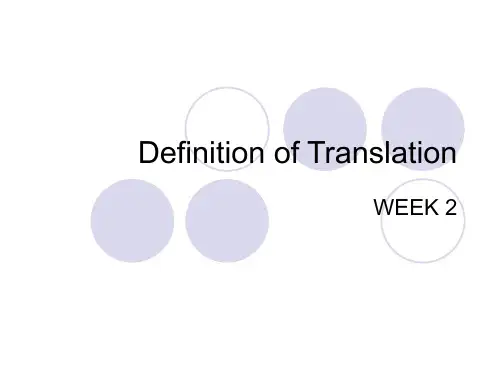
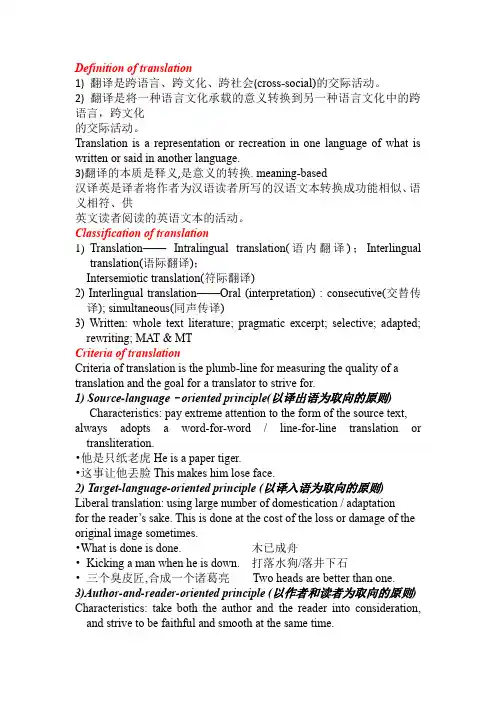
Definition of translation1) 翻译是跨语言、跨文化、跨社会(cross-social)的交际活动。
2) 翻译是将一种语言文化承载的意义转换到另一种语言文化中的跨语言,跨文化的交际活动。
Translation is a representation or recreation in one language of what is written or said in another language.3)翻译的本质是释义,是意义的转换. meaning-based汉译英是译者将作者为汉语读者所写的汉语文本转换成功能相似、语义相符、供英文读者阅读的英语文本的活动。
Classification of translation1)Translation—— Intralingual translation(语内翻译);Interlingualtranslation(语际翻译);Intersemiotic translation(符际翻译)2) Interlingual translation——Oral (interpretation) : consecutive(交替传译); simultaneous(同声传译)3) Written: whole text literature; pragmatic excerpt; selective; adapted; rewriting; MAT & MTCriteria of translationCriteria of translation is the plumb-line for measuring the quality of a translation and the goal for a translator to strive for.1) Source-language–oriented principle(以译出语为取向的原则)Characteristics: pay extreme attention to the form of the source text, always adopts a word-for-word / line-for-line translation or transliteration.•他是只纸老虎He is a paper tiger.•这事让他丢脸This makes him lose face.2) Target-language-oriented principle (以译入语为取向的原则) Liberal translation: using large number of domestication / adaptationfor the reader’s sake. This is done at the cost of the loss or damage of the original image sometimes.•What is done is done. 木已成舟•Kicking a man when he is down. 打落水狗/落井下石•三个臭皮匠,合成一个诸葛亮Two heads are better than one.3)Author-and-reader-oriented principle (以作者和读者为取向的原则) Characteristics: take both the author and the reader into consideration, and strive to be faithful and smooth at the same time.•繁华也罢,贫穷也罢,丈夫和妻子携手一生,情深意长。
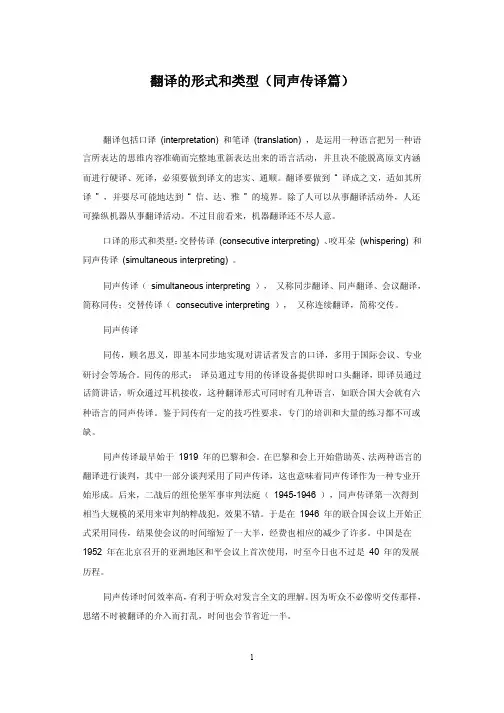
翻译的形式和类型(同声传译篇)翻译包括口译(interpretation) 和笔译(translation) ,是运用一种语言把另一种语言所表达的思维内容准确而完整地重新表达出来的语言活动,并且决不能脱离原文内涵而进行硬译、死译,必须要做到译文的忠实、通顺。
翻译要做到“ 译成之文,适如其所译” ,并要尽可能地达到“ 信、达、雅” 的境界。
除了人可以从事翻译活动外,人还可操纵机器从事翻译活动。
不过目前看来,机器翻译还不尽人意。
口译的形式和类型:交替传译(consecutive interpreting) 、咬耳朵(whispering) 和同声传译(simultaneous interpreting) 。
同声传译(simultaneous interpreting ),又称同步翻译、同声翻译、会议翻译,简称同传;交替传译(consecutive interpreting ),又称连续翻译,简称交传。
同声传译同传,顾名思义,即基本同步地实现对讲话者发言的口译,多用于国际会议、专业研讨会等场合。
同传的形式:译员通过专用的传译设备提供即时口头翻译,即译员通过话筒讲话,听众通过耳机接收,这种翻译形式可同时有几种语言,如联合国大会就有六种语言的同声传译。
鉴于同传有一定的技巧性要求,专门的培训和大量的练习都不可或缺。
同声传译最早始于1919 年的巴黎和会。
在巴黎和会上开始借助英、法两种语言的翻译进行谈判,其中一部分谈判采用了同声传译,这也意味着同声传译作为一种专业开始形成。
后来,二战后的纽伦堡军事审判法庭(1945-1946 ),同声传译第一次得到相当大规模的采用来审判纳粹战犯,效果不错。
于是在1946 年的联合国会议上开始正式采用同传,结果使会议的时间缩短了一大半,经费也相应的减少了许多。
中国是在1952 年在北京召开的亚洲地区和平会议上首次使用,时至今日也不过是40 年的发展历程。
同声传译时间效率高,有利于听众对发言全文的理解。
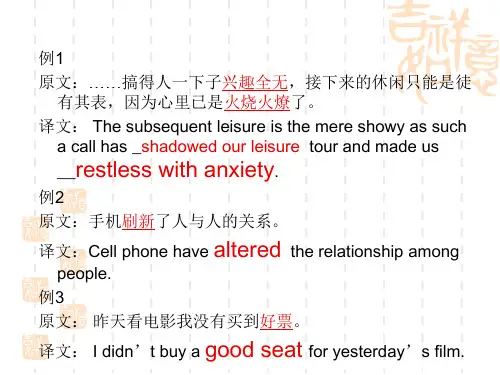

translation用法
在英语中,“translation”是一个名词,表示“翻译”或“译文”。
它可以用作主语、宾语或其他句子成分。
例如:
The translation of the book was very accurate.(这本书的译文非常准确。
)
The original text was translated into several languages.(原文被翻译成了几种语言。
)
I need someone who can translate English to Chinese.(我需要一个能够把英语翻译成中文的人。
)
除了作为名词,“translation”也可以用作动词,表示“翻译”或“转化”的行为。
例如:
The text was translated into French.(这段文字被翻译成了法语。
)
The scientist translated the formula into English.(科学家把这个公式翻译成了英文。
)
The translator translated the speech from English to Spanish.(翻译员将这篇演讲从英文翻译成西班牙文。
)。
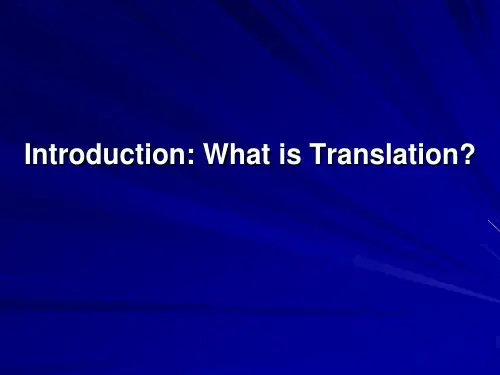
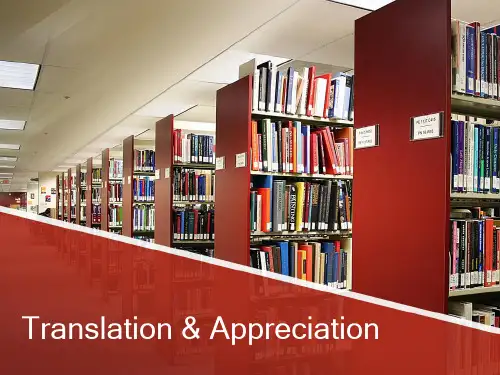
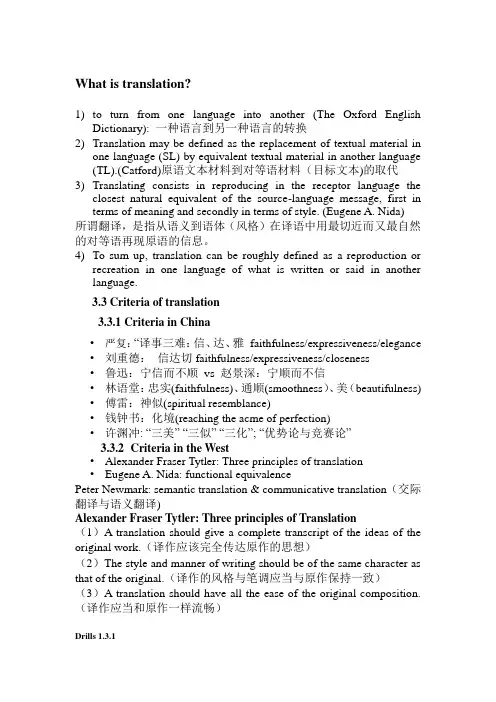
What is translation?1)to turn from one language into another (The Oxford EnglishDictionary): 一种语言到另一种语言的转换2)Translation may be defined as the replacement of textual material inone language (SL) by equivalent textual material in another language (TL).(Catford)原语文本材料到对等语材料(目标文本)的取代3)Translating consists in reproducing in the receptor language theclosest natural equivalent of the source-language message, first in terms of meaning and secondly in terms of style. (Eugene A. Nida)所谓翻译,是指从语义到语体(风格)在译语中用最切近而又最自然的对等语再现原语的信息。
4)To sum up, translation can be roughly defined as a reproduction orrecreation in one language of what is written or said in another language.3.3 Criteria of translation3.3.1 Criteria in China•严复:“译事三难:信、达、雅faithfulness/expressiveness/elegance •刘重德:信达切faithfulness/expressiveness/closeness•鲁迅:宁信而不顺vs 赵景深:宁顺而不信•林语堂:忠实(faithfulness)、通顺(smoothness)、美(beautifulness) •傅雷:神似(spiritual resemblance)•钱钟书:化境(reaching the acme of perfection)•许渊冲: “三美” “三似” “三化”; “优势论与竞赛论”3.3.2Criteria in the West•Alexander Fraser Tytler: Three principles of translation•Eugene A. Nida: functional equivalencePeter Newmark: semantic translation & communicative translation(交际翻译与语义翻译)Alexander Fraser Tytler: Three principles of Translation(1)A translation should give a complete transcript of the ideas of the original work.(译作应该完全传达原作的思想)(2)The style and manner of writing should be of the same character as that of the original.(译作的风格与笔调应当与原作保持一致)(3)A translation should have all the ease of the original composition.(译作应当和原作一样流畅)Drills 1.3.1(1) 1.This will go a long way towards overcoming the difficulty. 这对克服困难很有帮助。
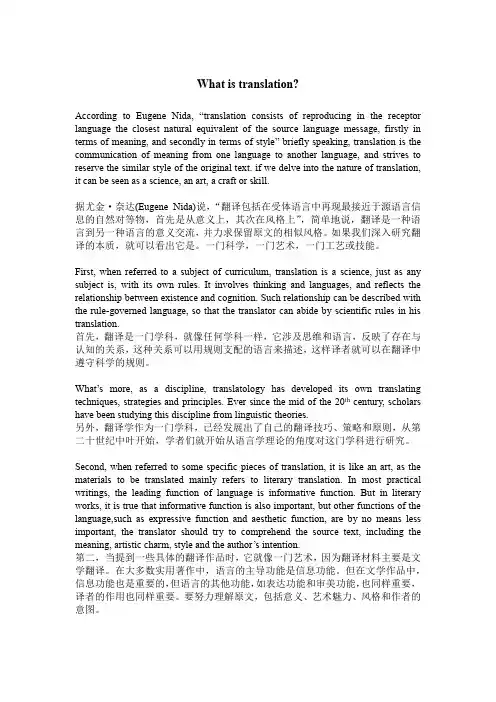
What is translation?According to Eugene Nida, “translation consists of reproducing in the receptor language the closest natural equivalent of the source language message, firstly in terms of meaning, and secondly in terms of style” briefly speaking, translation is the communication of meaning from one language to another language, and strives to reserve the similar style of the original text. if we delve into the nature of translation, it can be seen as a science, an art, a craft or skill.据尤金·奈达(Eugene Nida)说,“翻译包括在受体语言中再现最接近于源语言信息的自然对等物,首先是从意义上,其次在风格上”,简单地说,翻译是一种语言到另一种语言的意义交流,并力求保留原文的相似风格。
如果我们深入研究翻译的本质,就可以看出它是。
一门科学,一门艺术,一门工艺或技能。
First, when referred to a subject of curriculum, translation is a science, just as any subject is, with its own rules. It involves thinking and languages, and reflects the relationship between existence and cognition. Such relationship can be described with the rule-governed language, so that the translator can abide by scientific rules in his translation.首先,翻译是一门学科,就像任何学科一样,它涉及思维和语言,反映了存在与认知的关系,这种关系可以用规则支配的语言来描述,这样译者就可以在翻译中遵守科学的规则。
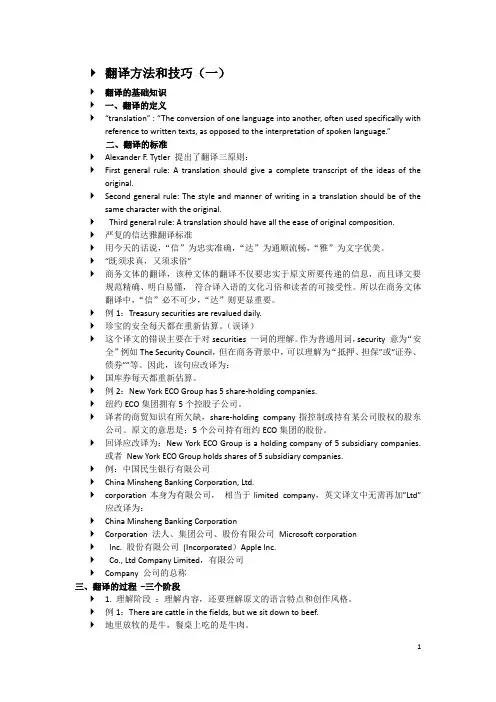
❝翻译方法和技巧(一)❝翻译的基础知识❝一、翻译的定义❝“translation” : “The conversion of one language into another, often used specifically with reference to written texts, as opposed to the interpretation of spoken language.”二、翻译的标准❝Alexander F. Tytler 提出了翻译三原则:❝First general rule: A translation should give a complete transcript of the ideas of the original.❝Second general rule: The style and manner of writing in a translation should be of the same character with the original.❝Third general rule: A translation should have all the ease of original composition.❝严复的信达雅翻译标准❝用今天的话说,“信”为忠实准确,“达”为通顺流畅,“雅”为文字优美。
❝“既须求真,又须求俗”❝商务文体的翻译,该种文体的翻译不仅要忠实于原文所要传递的信息,而且译文要规范精确、明白易懂,符合译入语的文化习俗和读者的可接受性。
所以在商务文体翻译中,“信”必不可少,“达”则更显重要。
❝例1:Treasury securities are revalued daily.❝珍宝的安全每天都在重新估算。
(误译)❝这个译文的错误主要在于对securities 一词的理解。
作为普通用词,security 意为“安全”例如The Security Council,但在商务背景中,可以理解为“抵押、担保”或“证券、债券””等。
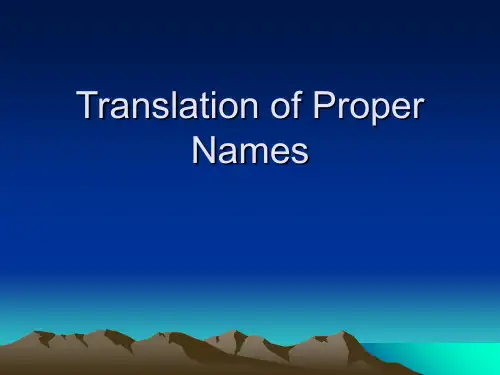
翻译的定义1词典定义:1)Translation is the communication of the meaning of a source-language text by means of an equivalent target-language text.-------- From Wikipedia, the free encyclopedia翻译,是指在准确通顺的基础上,把一种语言信息转变成另一种语言信息的活动。
2)《辞海》:把一种语言文字的意义用另一种语言文字表达出来。
3)《牛津英语词典》:在保留意义的情况下从一种语言转变成另一种语言4) Changing (speech or writing) from one language into another.-------------- Longman Dictionary of Contemporary English) 5)2 国内学者下的定义:老舍:翻译不是结结巴巴的学舌,而是漂漂亮亮的再创造傅雷:翻译如临画, 如伯乐相马,'重神似, 不重形似',得其精而忘其粗, 再其内而忘其外萧乾:翻译好象走钢丝,实在艰难……郭沫若:创作是处女, 翻译是媒婆。
---------黄忠廉.翻译本质论〔M〕.武汉:华中师范大学出版社,2000.14 -15 .茅盾:文学的翻译是用另一种语言,把原作的艺术意境传达出来,使读者在读译文的时候能够像读原作一样得到启发、感动和美的感受”。
(1954 年, 茅盾在当年全国文学翻译工作会议上所做的《为发展文学翻译事业和提高翻译译质量而奋斗》所作的报告)------矛盾.为发展文学翻译事业和提高翻译质量而奋斗[A] .罗新璋.翻译论集[C] , 北京:商务印书馆, 1984.朱维之:翻译是一种艺术……这是一种难度较大的艺术工作, 不但要把原著的字句翻译出来, 更主要的是要把它的思想、精神传达出来, 还要把作者的特殊风格表露出来.------翻译通讯编辑部.翻译研究论文集:1949 -1983[C]. 北京:外语教学与研究出版社, 1984.许渊冲:翻译的艺术就是通过原文的形式(或表层),理解原文的内容(或深层),再用译文的形式,把原文的内容再现出来。
1、翻译是把一种语言表达的意义用另一种语言传达出来,以达到沟通思想情感、传播文化知识、促进社会文明,特别是推动译语文化兴旺昌盛的目的。
Translation is an activity of reproducing in one language the ideas which have been expressed in another language.翻译理论家Eugene A. Nida Alexander Fraser Tytler2. Scope of Translation按语言分类in terms of languages:语内翻译(intralingual translation)语际翻译(interlingual translation)按活动形式分类in terms of the mode:笔译(translation)口译(oral interpretation)连续传译(consecutive translation)和同声传译(simultaneous translation)按翻译材料的文体分类in terms of materials to be translated:应用文体翻译科技文体翻译、论述文体翻译新闻文体翻译、艺术文体翻译按处理方式分类in terms of disposal:(全译full-text translation, 节译abridged translation, 摘译adapted translation编译compilation compile译述translate freely )3. Criteria in ChinaB. Yan Fu’s (严复) “three character guide”, which was first proposed in 1898 in the Preface of his translation of the book Natural Selection(《天演论》), is the principle of “faithfulness, expressiveness, and elega nce” (信、达、雅).Some revisions such as faithfulness, expressiveness and closeness (信、达、切); faithfulness, expressiveness and fitness (信、达、贴),D. Fu Lei’s (傅雷) spiritual conformity/resemblance in spirit (神似)E. Qian Zhongshu (钱钟书) transmigration (化境)鲁迅:翻译:力求其易解, 保存原作的丰姿。
1. 前苏联语言学派翻译理论家费道罗夫说:“翻译就是用一种语言把另一种语言在内容和形式不可分割的统一中业已表达出来的东西,准确而完全地表达出来。
”2. 前苏联文艺学派翻译理论家索伯列夫说:“翻译的目的就是把一种语言中的内容和形式移植到另一种语言中去。
”3. 前苏联翻译理论家巴尔胡达罗夫说:“翻译就是把一种语言的言语产物,在保持内容也就是意义不变的情况下,改变成另一种语言产物的过程。
”4. 尤金?奈达说:“所谓翻译,是指从语义到文体在译语中用最切近而又最自然的对等语再现原语的信息。
”Tran slation consists in producing in the receptor language the closest natural equivalent to the message of the source language, first in meaning , and secondly in style.《中国翻译辞典》(林煌天主编,1997)在引用了数位前苏联学者和尤金?奈达对翻译下的定义后,尝试着给翻译下了一个比较完备的定义:翻译是两个语言社会(language community)之间的交际过程和交际工具。
(这个比较完备的定义甚至不如《现代汉语词典》和《新华辞典》的定义更句概括力。
George Steiner在其《通天塔之后》After Babel——Aspects of Translation说:“按适当的理解,翻译是一个特定语言之内任何一次成功的言语行为所包含的交际过程。
”…translation, properly understood, is a special case of the arc of communication which every successful speech-act closes within a given language.” (After Babel P. 49)尼兰贾娜(Tejaswini Niranjana):翻译自始至终是个政治行为。
TranslationCixi was utterly fearful of foreigners just as she was extremely arrogant toward her own countrymen. She stopped for a long time in Henan and halted in Baoding for quite a few days before finally arriving in Beijing. It was said that an amusing episode took place during this long and drawn-out journey. When a local official offered a monkey to her as a gift, she was so pleased that she ordered a yellow mandarin jacket to the monkey. Later, she was told that some officials were complaining that people were considered less worthy than a monkey, then she realized that her order had been indeed a litter too whimsical. So she gave another order granting each of the escorting officials a yellow mandarin jacket. Upon the receipt of such an unusual favor, the officials did not know whether they should thank Cixi or rather the monkey for it.慈禧对外国人万分惧怕,正像她对国人无比傲慢一样。
她在河南停留了很长一段时间,到了保定又逗留多日,好不容易才回到北京。
据说,在这漫长的旅途中还发生了一件趣事。
一位官员送给慈禧一只猴子,她颇为高兴,竟让人给那只猴子穿黄马褂。
后来得知有的官员发出了“人不如猴”的感慨,慈禧才发现自己的决定有些荒唐,于是又命令给随行官员每人一件黄马褂。
得知如此殊荣之后,大家真不知道该感谢慈禧还是感谢那只猴子。
Mandarin, the official language of China, is suddenly hot in American schools. As China becomes the world’s leading economy in this century, both public and pr ivate schools are scrambling to add Mandarin to their roster of foreign languages or expand Chinese language programs already in place. By some estimates, as many as 50,000 children nationwide are taking Mandarin in school. The device to develop Chinese-language programs has met some difficulties. A shortage of trained, credentialed teachers has made it difficult for some schools to join the race. When schools need to employ teachers, they often recruit them from China, which is hidden trouble for a culture clash.中国的官方语言普通话在美国的学校中突然热起来。
由于中国经济在本世纪的领先地位,美国的公立和私立学校纷纷在外语教学中加入汉语这一科,或将已有的汉语教学项目进行扩展。
据统计,在美国的学校中,有5万名孩子在学习汉语。
推动汉语项目的发展不是没有遇到困难。
由于缺乏受过专业训练、持有证书的教师,一些学校很难加入汉语教学的竞争。
当学校聘用教师时,它们通常直接从中国将他们招来,这种方式为文化冲突埋下了隐患。
The word-famous Silk Road is a series of routes that connect the East and the West. The Silk Road extends more than 6,000 kilometers and gets its name from ancient China’s silk trade. The trade on the Silk Road has played a very important role in the development of civilizations in China, South Asia, Europe and the Middle East. It was through the Silk Road that the four great inventions of ancient China—papermaking, gunpowder, compass and printing—had been introduced to other parts of the world. Similarly, China’s silk, tea and porcelain had also been spread all over the world through it. The exchange of material culture is bilateral. Europe, in return, had exported various commodities and plants through the Silk Road, meeting the need of Chinese market.闻名于世的丝绸之路是一系列连接东西方的路线。
丝绸之路延伸6000多公里,得名于古代中国的丝绸贸易。
丝绸之路上的贸易在中国、南亚、欧洲和中东文明发展中发挥了重要作用。
正是通过丝绸之路,中国的造纸、火药、指南针、印刷术等四大发明才被引荐到世界各地。
同样,中国的丝绸、茶叶和瓷器也传遍全球。
物质文化的交流是双向的,欧洲也通过丝绸之路出口各种商品和植物,满足中国市场的需求。
The Silk Road dates back to the second century B.C. when a Chinese envoy Zhang Qian embarked on his business trip to western countries following this trade access linking Asia and Europe. Originating from the present-day Xi’an, the 7,000-kilometer route traversed the Hexi Corridor, the Tarim Basin, the port countries of West Asia, ending at the eastern shores of the Mediterranean. China brought its silk cloth, gunpowder, and papermaking and printing techniques to the West via this road. It, in return, introduced into China Buddhism and Islam as well as grapes, glass, and perfume from the outside world. Because the famous Chin a’s silk reached the West along this road, European scholars came to call it the “Silk Road”.丝绸之路可以追溯到公元前二世纪,中国使者张骞沿着这条连接亚欧两大洲得到贸易通道出使西域。
这条通道源于今日西安,一路穿越河西走廊、塔里木盆地以及西亚的港口城市,醉后抵达地中海的东岸,全程7千公里。
中国通过这条通道给西域各国带去了丝绸织物、火药、造纸术和印刷术。
同时,也从国外给我们引进了佛教、伊斯兰教,以及葡萄、玻璃、香水等产品。
因为著名的中国丝绸是沿着这条通道进入西方国家的,所以欧洲学者将此通道称作“丝绸之路”。
The Chinese garden has become a landscape of unique style after an evolvement for more than 3,000 years. It includes not only the large gardens built as entertainment venues for royal family, but also the private gardens built as secluded retreats for schools, merchants and retired government officials. These gardens have constituted a miniature designed to express the harmonious relationship between man and nature. A typical Chinese garden is surrounded by walls, and in the garden there are ponds, rockwork, trees, flowers and all kinds of buildings linked by winding trails and corridors. Wandering in the gardens, people may feel that a series of well-designed scenery spreads out before us like a landscape scroll.中国园林是经过三千多年演变而成的独具一格的园林景观。